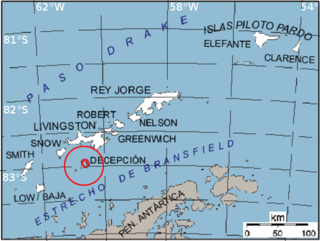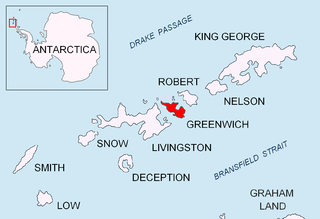Related Research Articles
Liège Island is an island, 17 kilometres (9 nmi) long and 5.6 kilometres (3 nmi) wide, lying immediately northeast of Brabant Island in the Palmer Archipelago, and separated from Hoseason Island and Christiania Islands to the northeast by Croker Passage. Its interior is occupied by Brugmann Mountains.

Adelaide Island is a large, mainly ice-covered island, 139 kilometres (75 nmi) long and 37 kilometres (20 nmi) wide, lying at the north side of Marguerite Bay off the west coast of the Antarctic Peninsula. The Ginger Islands lie off the southern end. Mount Bodys is the easternmost mountain on Adelaide Island, rising to over 1,220 m. The island lies within the Argentine, British and Chilean Antarctic claims.
Rymill Bay is a bay in Antarctica. It is 16.7 kilometres (9 nmi) wide at its mouth and indents 9.3 kilometres (5 nmi) between Red Rock Ridge and Bertrand Ice Piedmont along the west coast of Graham Land. Rymill Bay was probably first seen from a distance by the French Antarctic Expedition under Jean-Baptiste Charcot in 1909. The bay was first surveyed in 1936 by the British Graham Land Expedition (BGLE), and was resurveyed in 1948 by the Falkland Islands Dependencies Survey (FIDS). The name, proposed by members of the BGLE is for John Riddoch Rymill, Australian leader of the British Graham Land Expedition.

The Prince Charles Mountains are a major group of mountains in Mac. Robertson Land in Antarctica, including the Athos Range, the Porthos Range, and the Aramis Range. The highest peak is Mount Menzies, with a height of 3,228 m (10,591 ft). Other prominent peaks are Mount Izabelle and Mount Stinear. These mountains, together with other scattered peaks, form an arc about 420 km (260 mi) long, extending from the vicinity of Mount Starlight in the north to Goodspeed Nunataks in the south.
Rayner Glacier is a prominent glacier, 19 kilometres (10 nmi) wide, flowing north to the coast of Enderby Land just west of Condon Hills. It was sighted in October 1956 by Squadron Leader D. Leckie during a flight in an ANARE Beaver aircraft, and named by ANCA for J.M. Rayner, Director of the Bureau of Mineral Resources in the Australian Department of National Development.

Bransfield Strait or Fleet Sea is a body of water about 100 kilometres (60 mi) wide extending for 300 miles (500 km) in a general northeast – southwest direction between the South Shetland Islands and the Antarctic Peninsula.
Pedro Bank is a large bank of sand and coral, partially covered with seagrass, about 80 km south and southwest of Jamaica, rising steeply from a seabed of 800 metres depth. It slopes gently from the Pedro Cays to the west and north with depths from 13 to 30 metres. The total area of the bank within the 100-metre (328-foot) isobath measures 8,040 square kilometres. The area of a depth to 40 metres is triangular, 70 kilometres long east-west, and 43 kilometres wide. 2,400 square kilometres are less than 20 metres deep. With its islets, cays and rocks, a total land area of 270,000 m2 (2,906,256 sq ft), it is the location of one of the two offshore island groups of Jamaica, the other one being the Morant Cays. The bank is centered at 17°06′N78°20′W.

The Ibar Rocks are two rocks located 0.4 kilometres (0.2 nmi) east of Bonert Rock and 1 kilometre (0.6 nmi) southeast of Canto Point, Greenwich Island, in the South Shetland Islands. The names "Islote Ibar" and "Islote Teniente Ibar" appearing on Chilean hydrographic charts in the 1950s refer to the larger and western rock. The recommended name "Ibar Rocks" includes a submerged outlier to the northeast of the larger rock. Teniente (lieutenant) Mario Ibar P. signed the official act of inauguration of the Chilean Captain Arturo Prat Base on Greenwich Island in 1947.

Morton Strait is the 9 km (4.9 nmi)-long and 6.2 km (3.3 nmi)-wide strait between Snow Island on the southwest and Rugged Island and Livingston Island on the northeast, in the South Shetland Islands, Antarctica. The Aim Rocks and Long Rock lie in the strait.
The Wog Wog River is a perennial river of the Towamba River catchment, located in the South Coast region of New South Wales, Australia.
The Porthos Range is the second range south in the Prince Charles Mountains of Antarctica, extending for about 30 miles in an east-to-west direction between Scylla Glacier and Charybdis Glacier. First visited in December 1956 by the Australian National Antarctic Research Expeditions (ANARE) southern party under W.G. Bewsher (1956-57) and named after Porthos, a character in Alexandre Dumas, père's novel The Three Musketeers, the most popular book read on the southern journey.
William Scoresby Bay is a coastal embayment at the western side of William Scoresby Archipelago, Antarctica. It is 8 kilometres (5 mi) long and 5.6 kilometres (3.5 mi) wide, with shores marked by steep rock headlands and snow-free hills rising to 210 m. The practical limits of the bay are extended 6.4 kilometres (4 mi) northward, from the coast by island groups located along its east and west margin. Discovered in February 1936 by Discovery Investigations (DI) personnel on the RRS William Scoresby, for which the bay was named. The bay separates the Kemp Coast to the east from the Mawson Coast to the west. The Hobbs Islands sit 19 kilometres northeast.
The Boobyalla Islands are two small islands 4 kilometres (2 nmi) northeast of Kirkby Head, Enderby Land. They were plotted from air photos taken from Australian National Antarctic Research Expeditions aircraft in 1956, and named by the Antarctic Names Committee of Australia after the Australian native willow, "Boobyalla".

Borceguí Island is an ice-free island in the South Shetland Islands, midway between Cape Yelcho and the Gibbous Rocks, 2 kilometres (1 nmi) off the north coast of Elephant Island. The name was applied by the command of the Argentine sea-going tug Chiriguano in the 1954–55 cruise; in Spanish "borceguí" means half-boot and describes the shape of the island.
Stevens Rock is a small, lone bare rock 2.8 kilometres (1.5 nmi) east of Strahan Glacier and 2 kilometres (1 nmi) off the coast of Antarctica. Discovered in February 1931 by the British Australian New Zealand Antarctic Research Expedition (BANZARE) under Mawson, who named it for Commander C.W. Stevens, Hydrographic Dept., Royal Australian Navy.
The Hansen Rocks are a group of five small islands lying just north of Holme Bay and the coast of Mac. Robertson Land, Antarctica, about 2 kilometres (1 nmi) northeast of the Sawert Rocks and Nella Rock, and about 2 kilometres (1 nmi) northwest of the Canopus Rocks. They were plotted from Australian National Antarctic Research Expeditions (ANARE) air photographs, and were named by the Antarctic Names Committee of Australia for Captain B.T. Hansen, master of the Nella Dan for ANARE relief voyages in 1968, 1969, 1970 and 1972.

The Marshall Archipelago is an extensive group of large ice-covered islands within the Sulzberger Ice Shelf off Antarctica. Several of the islands were discovered and plotted by the Byrd Antarctic Expeditions and by the United States Antarctic Service (1939–41), all led by Admiral Richard E. Byrd. The full extent of the archipelago was mapped by the United States Geological Survey from surveys and U.S. Navy air photos (1959–65). The name was proposed by Admiral Byrd for General of the Army George C. Marshall, who made financial contributions as a private individual and also, on the same basis, provided advisory assistance to the Byrd expedition of 1933–35.
Sawert Rocks is a group of rocks 4.6 kilometres (2.5 nmi) east-northeast of Azimuth Island, and about 3.7 kilometres (2 nmi) southwest of the Hansen Rocks, in the northeast part of Holme Bay, Mac. Robertson Land. Plotted from photos taken from ANARE aircraft in 1958. Named by Antarctic Names Committee of Australia (ANCA) for A. Sawert, radio officer at Mawson Station in 1959. Just to the east of the Sawert Rocks lies Nella Rock.
Smith Rocks is a group of rocks lying 1 kilometre (0.5 nmi) northeast of Canopus Islands, 1 kilometre (0.5 nmi) west of Kitney Island, 3.7 kilometres (2 nmi) southwest of Wiltshire Rocks, and 5.6 kilometres (3 nmi) northwest of Paterson Islands, in the east part of Holme Bay, Mac. Robertson Land. Mapped by Norwegian cartographers from air photos taken by the Lars Christensen Expedition, 1936–37, and named Spjotoyholmane. Renamed by Antarctic Names Committee of Australia (ANCA) for Captain V. Smith, RAASC, DUKW driver who took part in ANARE changeover operations at Davis and Mawson stations in 1958-59 and 1959–60.
References
![]() This article incorporates public domain material from "Ryrie Rock". Geographic Names Information System . United States Geological Survey.
This article incorporates public domain material from "Ryrie Rock". Geographic Names Information System . United States Geological Survey.